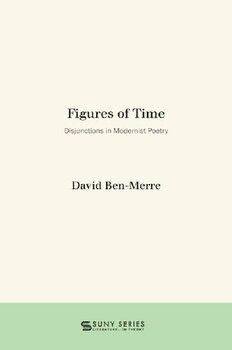
Figures of Time: Disjunctions in Modernist Poetry PDF
Preview Figures of Time: Disjunctions in Modernist Poetry
Figures of Time SERIES EDITORS David E. Johnson (Comparative Literature, SUNY Buffalo) Scott Michaelsen (English, Michigan State University) SERIES ADVISORY BOARD Nahum D. Chandler, African American Studies, University of California, Irvine Rebecca Comay, Philosophy and Comparative Literature, University of Toronto Marc Crépon, Philosophy, École Normale Supérieure, Paris Jonathan Culler, Comparative Literature, Cornell Johanna Drucker, Design Media Arts and Information Studies, UCLA Christopher Fynsk, Modern Thought, Aberdeen University Rodolphe Gasché, Comparative Literature, SUNY Buffalo Martin Hägglund, Comparative Literature, Yale Carol Jacobs, Comparative Literature & German, Yale University Peggy Kamuf, French and Comparative Literature, University of Southern California David Marriott, History of Consciousness, University of California, Santa Cruz Steven Miller, English, University at Buffalo Alberto Moreiras, Hispanic Studies, Texas A&M University Patrick O’Donnell, English, Michigan State University Pablo Oyarzún, Teoría del Arte, Universidad de Chile Scott Cutler Shershow, English, University of California, Davis Henry Sussman, German and Comparative Literature, Yale University Samuel Weber, Comparative Literature, Northwestern Ewa Ziarek, Comparative Literature, SUNY Buffalo FIGURES OF TIME Disjunctions in Modernist Poetry David Ben-Merre Published by State University of New York Press, Albany © 2018 State University of New York All rights reserved Printed in the United States of America No part of this book may be used or reproduced in any manner whatsoever without written permission. No part of this book may be stored in a retrieval system or transmitted in any form or by any means including electronic, electrostatic, magnetic tape, mechanical, photocopying, recording, or otherwise without the prior permission in writing of the publisher. For information, contact State University of New York Press, Albany, NY www.sunypress.edu Production, Jenn Bennett Marketing, Fran Keneston Library of Congress Cataloging-in-Publication Data Names: Ben-Merre, David 1978- author. Title: Figures of time : disjunctions in modernist poetry / David Ben-Merre. Description: Albany : State University of New York Press, 2017. | Series: Suny series, literature in theory | Includes bibliographical references and index. Identifiers: LCCN 2017011556 (print) | LCCN 2017027951 (ebook) | ISBN 9781438468341 (e-book) | ISBN 9781438468334 (hardcover : alk. paper) Subjects: LCSH: Poetry, Modern--History and criticism. | Modernism (Literature)--United States. | Modernism (Literature)--Great Britain. Classification: LCC PN1271 (ebook) | LCC PN1271 .B46 2017 (print) | DDC 809.1/04--dc23 LC record available at https://lccn.loc.gov/2017011556 10 9 8 7 6 5 4 3 2 1 For the love of my life . . . CONTENTS | “ ” ix PREFACE ON TIMELINESS xxiii ACKNOWLEDGMENTS | 1 INTRODUCTION FIGURING ANACHRONY Kurt Gödel and Other Liars: The Metaleptic Methods of Modernity : PART I FIGURES OF OPPOSITION | 35 CHAPTER ONE PARADOX “Inherent Opposites, / Of Essential Unity”: Wallace Stevens’s “Connoisseur of Chaos” | 57 CHAPTER TWO REVISION “The Brawling of a Sparrow in the Eaves”: Revision and the Romantic Imagination in W. B. Yeats : PART II FIGURES OF RECOLLECTION | 81 CHAPTER THREE MEMORY Shellfish Readings: On H.D., Nachträglichkeit, and Anagrammatic Wanderings | 119 CHAPTER FOUR TRADITION “Strange Spars of Knowledge and Dimmed Wares of Price”: Ezra Pound, “Portrait d’une Femme,” and the Literary Anthology : PART III FIGURES OF SELF | 139 CHAPTER FIVE VOICE We’re, Like, Talking on the Page: Sound, Simile, and the [Langston] Hues of African American Verse | 169 CHAPTER SIX LYRIC IDENTITY “The Patient Is No Longer Here”: T. S. Eliot’s Late Lyric Moment 191 NOTES 255 WORKS CITED 283 INDEX | PREFACE ON “TIMELINESS” THE GREATEST FAILURE OF A BOOK IS ITS UN-TIMELINESS, its placement into a world that has moved beyond its concerns. My hope here is to reimagine the timely possibilities of modernist poetics within the critical debates of the past few generations. The book takes, as a jumping-off point, the rhetorical overlap between the expectations of current scholarly work and theories of modernism, each a facet of modernity and each symptomatically espousing “newness” in its own way. The introductory chapter ties together critical theories of modernism with modern theories of criticism, likening both to an old paradoxical bind, which I argue is temporal in nature. Rather than have my remaining chapters echo this specific claim, I attempt to push the boundaries of how we have come to understand the variously complicated cultures of temporality that lurk behind, inside, and around modernist poems. The scholarly work on modernism and time is exhaustive. To borrow a phrase from Joseph Conrad, “It has got filled with rivers and lakes and names.” Rather than re-exploring what Dinos Patrides called “aspects of time”1—the important but now well-trod ground comparing literature to “new” senses of eschatological (Augustine),2 subjective (Woolf),3 ethical (Bergson),4 industrialized (Marx),5 or cosmological (Einstein)6 time—I look at how nuances of poetic form, often disjunctions of sound and sense, alter how temporalities might be understood. By listening to the sounds of words, I make an unsound claim, arguing that poetic figures of time (which are as much historical as tropological) often have a backward etiology.7 I turn to the strange temporal figure of metalepsis, which, for the purposes of this book, I understand in its tropological sense as a substitution of cause for effect, where, anachronistically, “later” events are thought to bring about earlier instantiations.8 Against the historicist claim that the present structures the present, I argue that in some manners of cultural understanding, the future structures the present.9 Such inversions arise significantly in various poetic guises and, although related to their narratological cousins, seem to follow a different sort of figurative logic, challenging the supposed grounds of understanding. In a sense, something odd happens to our cultural categories (how we have come to understand our world) once time is seen as a figural effect. Pairing poets with what I call different metaleptic “figures of time”—a poet revising, a lyric subject trying to capture an earlier moment, an identity trying to shape itself—I consider how each cultural temporality ix
